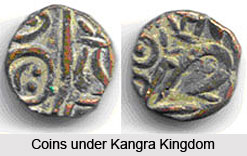 Kangra was small hilly kingdom located between the rivers Ravi and Sutlej in the western part of Himachal Pradesh. Till the time of the Muslim incursions in India, not much was known about the region.
Kangra was small hilly kingdom located between the rivers Ravi and Sutlej in the western part of Himachal Pradesh. Till the time of the Muslim incursions in India, not much was known about the region.
The rulers of Kangra occasionally submitted to the Muslim forces but meanwhile they also maintained their independence. During this period, the rulers of Kangra issued coins of the bull and horseman type of Samantadeva. From the beginning of the fourteenth century A.D., copper coins were found that bore the name of the rulers of the state. The earliest coins of this particular type bore the name of Rupachand as `Sri Rupa` on the horseman side and soon his name was transferred to the bull side. During the time of Apurvachand, the reverse bull motif was eliminated and the entire flan was used for a long legend `Maharaja Sri Apurvachand Deva`. From then onwards, till the beginning of the seventeenth century A.D., this pattern of coins were followed by the successive rulers. Gradually the figure of the horseman was adulterated and the figure was not exactly recognisable on the coins.
It had been said that this type of coin was also followed by the neighbouring states. The later rulers had possibly developed the style and patterns of the coins during their reigning period, to create a mark on the numismatic history of India.
This article is a stub. You can enrich by adding more information to it. Send your Write Up to content@indianetzone.com






































